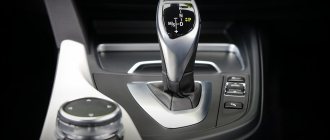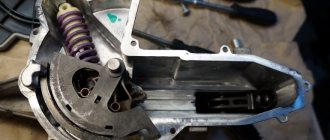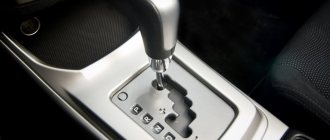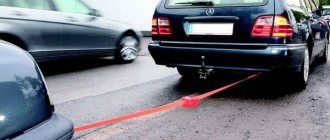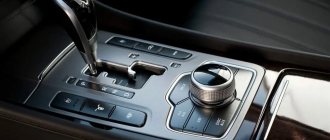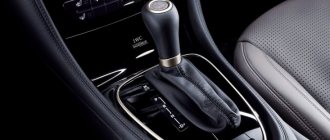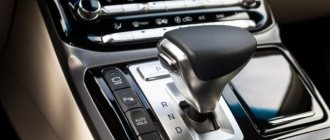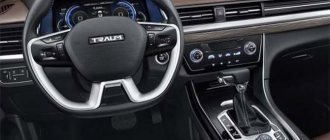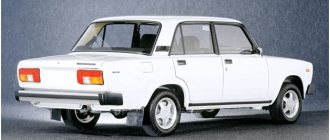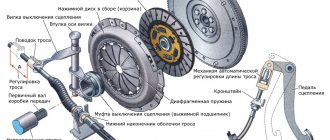In terms of its design features, a robotic gearbox is a manual transmission, with the exception that gear shifts and clutch operation are carried out using an ECU and servomechanisms.
This box has both its pros and cons. The main advantage is fuel efficiency, as well as the relative ease of production of single-disc AMT type robots. As for preselective robotic gearboxes (DSG and analogues), their main advantage is the double clutch, due to which gear changes occur very quickly and unnoticed by the driver.
The disadvantages of both types of robotic gearboxes are very rapid wear of clutch packs, individual actuators, contamination of sensors, souring of contacts, problems with mechatronics, solenoids, etc.
At the same time, repairing and servicing the robot box will not cost the car owner cheap. For this reason, it is necessary to maintain the manual transmission on time and operate the unit correctly. Next, we will look at the features of operation and maintenance of the robot box, and also answer the question of whether the robot box can be towed.
Is it possible to tow a car without oil in the box?
Experienced mechanics do not recommend towing
a car with
an automatic transmission
for long distances. The unit receives load, but there is no lubrication for it.
Interesting materials:
What constituent document is provided for a limited liability company? What is a universal text file format available for various text editors that completely preserves the formatting of the document? What universal text file format fully preserves document formatting? What legislative document establishes the procedure for investigating an industrial accident? What legislative document establishes the rights, duties and responsibilities of military personnel? What Sub-Style does such a document as a law belong to? What is the validity period of organizational legal documents? List the exceptions? What is the validity period of organizational legal documents? What is the storage period for documents confirming cash settlements with customers? What is the shelf life of electronic documents?
How to drive a car with a “robot”: 6 rules that few people know about
A robotic preselective gearbox is essentially a manual gearbox with two clutches, servos and a control unit. It differs from simple robotic gearboxes in that it can simultaneously keep two gears engaged and allows you to smoothly transition from one to another with almost no interruption in the power flow. The most common option is the Volkswagen DSG and its analogues on Skoda and Audi cars. Kia's version is called DCT, Ford's is called Powershift.
From the driver's point of view, preselective gearboxes work as comfortably as hydromechanical ones, but provide faster response of the power unit, instant gear changes and fuel economy at the level of conventional “mechanics”. A DSG type gearbox does not require any special knowledge or manipulation from the driver.
A robotic gearbox costs less than an automatic transmission, but is not inferior to the latter in terms of functionality, so there will be more and more such systems on the market. But the operation of such a unit requires some attention from the owner. It is important to understand that in order to maintain the normal operation of the preselective gearbox up to 200 thousand km, you will have to follow simple rules.
A “robot” with two clutches is installed on many models of the Volkswagen concern. Today there are two main types of preselective gearboxes - the “dry” seven-speed DSG-7 and the “wet” six-speed DSG-6, in which the clutches operate in an oil bath. In both cases, clutch discs wear out due to aggressive driving style, sudden acceleration, slipping and other incorrect actions. We have collected six basic rules for owners of a car with a DSG that will help extend the life of such a box.
The manufacturer does not provide for replacing or adding oil in the preselective gearbox throughout its entire service life, and this applies to boxes with both “dry” and “wet” clutches. But experienced mechanics still recommend replacing fluids, especially in difficult operating conditions.
Every 60 thousand km of the car, it is recommended to change the oil in the gearbox along with the oil filter, as well as the oil in the mechatronics control unit. The cost of replacement is 5–10 thousand rubles. depending on the oil and service. It is possible to change the oil yourself, but this can only be done by an experienced mechanic using some equipment.
The electronics of the preselective gearbox adapts to the driver’s driving style and begins to engage the desired speed a little in advance and engages the clutch at the right moment. When the driver presses the accelerator, the transmission prepares an upshift in advance, and a downshift when braking.
When driving aggressively with sharp acceleration/braking cycles, the automatic transmission gets confused and does not have time to select the right gear and shifts as quickly as possible, which creates additional loads on the clutch discs. With this type of driving, it is better to control the transmission in manual mode, although this will not help to fundamentally change the load.
Another important point that owners of cars with a “robot” should know: it is necessary to press the brake pedal well when stopping and switching gearbox modes. When you press the brake pedal lightly, the car is in the starting mode, the clutch discs do not open completely, which causes them to wear out faster.
It is recommended to switch the box selector smoothly, or better yet, with a slight delay. The absence of a pause when transitioning, for example, from “reverse” to “drive” will lead to an unpleasant jerk. Additionally, the electronics take a little time to set up. And when switching to parking mode, it is recommended to put the car on the “handbrake” before releasing the brake pedal or use the automatic activation mode of the parking brake. After this action, it will be easier for the box the next time it starts, especially uphill.
Is it possible to tow a Solaris automatically?
A vehicle equipped with an automatic transmission can be towed with the engine not running at a speed of no more than 50 km/h for a distance of no more than 30 km. Otherwise, the gearbox will fail, since the automatic transmission fluid pump does not work and its parts are not lubricated.
Interesting materials:
What is a metro? What are interstate and international relations? What is the instantaneous speed of uneven motion? What are instant notifications in VK? What is indicator flashing? What is mineral powder? What is the world of ideas? What is world politics? What is mycelium? What are mode and median in mathematics?
A car with automatic transmission as a tractor
Based on the fact that this type of vehicle is often used for transporting trailers, the answer to the question of whether it is possible to tow another with a car with an automatic transmission will be positive.
However, at the same time, the gearbox experiences enormous loads, therefore, in order to avoid premature failure, certain rules should be followed:
- tow an automatic car with another one equipped with an automatic transmission, only using special couplings;
- do not tow a vehicle whose weight exceeds the tractor;
- drive as smoothly as possible;
- do not press the gas pedal all the way;
- stop regularly.
Following these basic tips will help minimize the likelihood of transmission failure.
Let's sum it up
Taking into account the reduced reliability of robotic gearboxes, it is a mistake to believe that this type of transmission is a complete analogue of a manual transmission, which differs from mechanics in its automated gear selection and clutch operation. In fact, manual transmissions are more “fragile”, not designed for high loads, etc.
We also recommend reading the article on how to properly ride a robot box. From this article you will learn about the features of operating a manual transmission to increase the service life of the unit. The clutch in such boxes wears out much faster than in the case of mechanics. Servo mechanisms also have a small resource. As for preselective gearboxes, such a robot is a complex combination of mechanics and classic automatic transmissions, since there is a valve body (mechatronics), two clutch packages, and servomechanisms.
At the same time, by adhering to all of the above recommendations for the operation and maintenance of a car equipped with a manual transmission, you can not only avoid expensive repairs, but also extend the overall service life of the gearbox and its individual components.
Finally, we note that if a car with a robot gearbox is technically faulty and cannot continue to move under its own power, it is better to use the services of a tow truck. If it is necessary to tow a manual transmission, you must follow the rules prescribed by the manufacturer of the car or transmission for this transmission.
Why can't you tow a car with faulty brakes using a flexible cable?
Why is it prohibited to tow a car with faulty brakes using a flexible cable? ... A vehicle with faulty brakes continues to move when the lead vehicle stops and an accident may occur.
Interesting materials:
How to disable a hidden number active Kazakhstan? How to disable a hidden number on a Nokia phone? How to disable SMS to Beeline short numbers? How to disable SMS from number 2002? How to disable SMS from number 312? How to disable SMS from number 5016? How to disable messages from MTS short numbers? How to disable the Vodafone Caller ID service? How to disable the room rent 50 service? How to disable the service from number 5016?
Types of automatic transmission
Car owners traditionally call the entire transmission of a car a gearbox. From a technical point of view, the gearbox is considered to be only that part of the unit in which a number of planetary gears are located that ensure gear shifting.
An automatic transmission can be considered any device that changes gears without driver intervention, but traditionally the name “automatic transmission” has been assigned to a hydromechanical design. Conventionally, automatic transmissions also include a variator and a robotic gearbox.
Traditional automatic transmission
A traditional automatic transmission includes: a torque converter, a manual gearbox and a control system. And it is, in fact, a hydromechanical transmission. The torque converter in the automatic transmission acts as a clutch, i.e. it provides smooth supply and adjustment of torque from the engine to the gearbox. All its parts are enclosed in a housing in which they are in a special oil fluid - ATF.
When the engine starts, the crankshaft begins to rotate, and the movement of the torque converter pump wheel starts. It moves the ATF working fluid to the turbine wheel, which begins to rotate and transmits torque to the planetary gearboxes. The torque converter develops maximum torque at minimum speed.
As the speed increases further, the rotation of the pump and turbine wheels are aligned, the torque converter is locked, and torque is transferred directly from the engine to the manual transmission. Thus, when you press the gas pedal and increase the speed and vice versa, the gears are switched automatically.
Type-tronic
The type-tronic design is a type of automatic transmission that has a manual control mode. The driver can select gears manually while driving by moving the lever in the "+" and "-" directions. The structure of such a box is not fundamentally different from the traditional one; only the automatic control and gear shift lever are changed.
Driving a car with a type-tronic gearbox can be performed in two modes: full automatic and manual control. Manual mode imitates the control of a manual transmission in a sports car, but does not require the same serious skills and qualifications from the driver as from professional athletes in auto racing mode.
Robotic box
This transmission can be conditionally classified as automatic, since, in fact, it is a manual gearbox, but with electronic control. Gear shifting and clutch engagement are controlled automatically. The driver and driving conditions provide the input of information, and the operation of the box itself is started by an electronic unit, which contains a specific control algorithm.
The electronic control system includes sensors that receive information about rotation speed, selector lever position, oil level and pressure. They transmit information to the control unit, which analyzes them and selects the appropriate operating algorithm.
The robotic box can operate in two modes: full automatic and semi-automatic. Semi-automatic mode allows the driver to manually select the mode using a lever. This function is similar to the type-tronic in an automatic transmission. In some sources, the robotic gearbox is called a sequential gearbox.
Variable speed drive
The CVT transmission has the generally accepted abbreviation CVT, which in its full form means “continuously variable transmission”. The variator does not have fixed gears and switching between them. During operation, the variator constantly smoothly changes the gear ratio as the vehicle speed changes, so this design very conventionally applies to gearboxes.
The design of a CVT transmission consists of two pulleys and a V-belt stretched between them. The pulleys consist of two cones, the narrow part facing each other. The change in gear ratio occurs due to the smooth sliding of the belt along a smaller or larger radius of the pulley, so when moving, the torque changes continuously and there are no jerks.
The CVT provides comfortable driving, maximum efficiency in using engine power and fuel economy. However, due to the high complexity of the design, repairing the CVT box is very expensive.
What is the difference between manual transmission and automatic transmission when towing?
When transporting a manual transmission using the towed method, one gear rotates.
Moreover, even a switched off engine does not stop the lubrication process. Towing a car with an automatic transmission is different in that the automatic transmission, when neutral gear is engaged, continues to operate at full power, that is, the entire mechanism is in motion. In this case, the machine inevitably overheats, which ultimately results in a reduction in its service life. The situation is further aggravated by the fact that the oil pump serving the gearbox is correlated with the operation of the internal combustion engine.
DSG adaptation
Adaptation is a procedure for adjusting the operation of the gearbox and mechatronics unit, which is necessary after repairs and in some cases when the gearbox is not working correctly.
The procedure is simple and can be done with your own hands. Usually adaptation is carried out through Vag Com. Vag Com is a diagnostic program that will allow you to “make friends” of a car with a computer, diagnose and configure some systems. The program has a simple and intuitive interface, it takes up little disk space and it has its advantages compared to its analogues. To ensure that the adaptation is carried out correctly, follow this algorithm: — The gearbox is in position P and warmed up to 30–100 degrees C;
— The brake pedal is pressed during the entire procedure.
If all conditions are met, you need to connect Vag Com. The adaptation is done as follows:
DSG robotic transmission selector
- In the program interface we find the item Basic automatic transmission settings.
- Select the Gear Clutch Settings item and click “Go!” The box will begin to make sounds, and the numbers in the program will change. You need to wait until this stops.
- Select the Gear Shift Points item and click Go. Similar to point 2, we wait.
- Select the Clutch Adaptation item, the actions are similar to point 2. Then we do everything the same way as point 2.
- Item Basic settings.
- Item Pressure adaptation.
- Item With gear shift paddles installed.
- Item ESP and Cruise.
- Click Done.
- Turn off the ignition.
- We wait a few seconds.
- Turn on the ignition.
- We look for errors and remove them if necessary.
- We exit the controller.
- Without using cruise control, we perform a test drive.
- Quit them Vag Com. Adaptation is complete.
Replacing the mechatronics unit will require new firmware. Fortunately, this is easy to do. The mechatronics DSG 6 and mechatronics DSG 7 control units can be easily reflashed using this program.
How to distinguish an automatic transmission from a CVT and a robot?
It is easy to distinguish a classic automatic transmission from a robotic one by looking at the gearshift lever. The top position of the automatic transmission is indicated by the “P” icon - parking. When instead of this icon there are only the designations “N” - neutral and “R” - rear, we have a robotic device in front of us.
Interesting materials:
What is vehicle stability control? What is a systemic herbicide? What is systolic and diastolic blood pressure? What is the plot and composition of the work? What is an ATM skimmer? What is an edge bevel? What are fasteners in a magnet? What is scratch? What is a Car Mechanic? What are complex prepositions?
Consequences of transportation without following the rules
If you tow a machine gun in violation of the recommendations, the risk of malfunctions increases significantly. Their main reason is the lack of lubricant circulation and severe overheating. Breakdowns largely depend on the model of the box, the most common of which are:
- Increased wear of friction clutches. Because of this, the box begins to slip. The problem will be solved only by replacing worn elements. Other parts that are subject to high loads may also wear out.
- Torque converter failure. Because of this, the box will slip at best, and stop working at worst. The problem is extremely undesirable, since repairs will be expensive.
- Melting of electronic and other components due to overheating. There are many components in automatic transmissions that begin to melt when the permissible temperature is exceeded. The cost of eliminating such breakdowns can vary, it all depends on the failed unit and the complexity of the repair.
- Destruction of gears and other moving parts due to temperature and lack of lubrication. The risk of such problems increases significantly if the speed limit is not observed.
In case of complex faults, it is easier to buy a working used box than to invest a lot of money in repairs.
To avoid such problems, you need to tow your car correctly. Following simple tips reduces the risk of breakdowns significantly. But even if they arise, they are most often uncomplicated.
